I added British units in Syria and Iraq, based on garrison requirements, as well as specious Soviet troops around Tibilsi. Grabbed the latter from Winter War. Always like to PUB (Pretty Up The Battlefield).
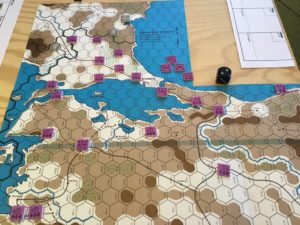


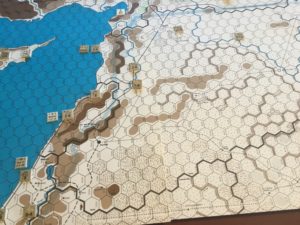
I added British units in Syria and Iraq, based on garrison requirements, as well as specious Soviet troops around Tibilsi. Grabbed the latter from Winter War. Always like to PUB (Pretty Up The Battlefield).




Have everything set up and ready to go. The Neutral Order of Battle calls for Turkey to receive foreign aid in the form of replacement points for upgrading units. The Allies historically provided aid to Turkey.
I’ll use the acceptance of this Allied aid as another pretext for invasion, but will only complete one-half the 1942 upgrades.
The overall effects convert infantry divisions from supported to non-supported, upgrades the 6-4-8 light armored division to a 7-10 armored division, and adds 1 ARP, as well as Hurricanes and P-40s to the Turkish air arsenal.
Added corps troops, with Army command retaining control of some assets, including the parachute division. The Italians provide a weak “division” to be used for rear area security (RAS). The weak German 52nd Corps, really a reinforced division, will perform RAS and airfield construction duties.
Due to the demands of other theaters, Fliegerkorps I contains a mix of older Luftwaffe assets. The antiaircraft units’ primary mission is airfield security. Aircraft mix and density is also driven by a weak air opponent and the need for maximum tactical air support.
One picture is supposedly worth a thousand words.

World At War Issue #49 provides the basics task organization for German forces deployed in either Bulgaria or Greece. War In The Desert (WITD) contains Turkish units and their initial dispositions.
However, what about allies?
At first, I assumed Germany would call on its Bulgarian allies for significant assistance. In addition, it’s possible that revanchist Greek and pro-fascist Yugoslavian units (Chetniks) might be formed. While the latter would be of little value in the initial attacks, they could provide rear area/security forces.
On second thought, I decided not to use these forces. Supposedly there was a good deal of pro-German sentiment in Turkey due to their close relations before and during World War I. To invade with long standing enemies would eliminate the possibility of any support from the nationalist Turks, much less put them in a security role policing Turkish cities. However, Bulgarian and Greek troops might be useful if massed at the border to tie down Turkish forces.
The Germans would be on their own, with limited ground and air assistance from the Italians, ever eager for a piece of any territorial or resource pie, but already stretched thin in North Africa.
I still have to figure out what assistance the Turks might receive from either the United States and/or Great Britain. I am assuming that the Soviet Union will be too hard pressed by the Wermacht’s summer offensives and need to hold their portion of the Iranian oil fields to provide any help to the Turks.
The next post will cover the Axis forces in detail, plus a thrilling photo of initial Turkish dispositions.
Huge Disclaimer Primarily For Those That Were And Have Probably Been Involved In Flame Wars In Any Form Of Europa List Past, Present And Future……
This is not an attempt at crafting an A Strange Alternate History Scenario……..Just playing with counters and possibilities.
Every time War In The Desert (WITD) comes off the shelf, I’ve looked at all those Turkish counters, and what a waste it is they remain neutral and unplayed.
Information concerning “Gertrude”, the German plan to invade Turkey, seems scarce and vague. Strategy and Tactics published a World At War game a couple of years ago. I bought it, looked it over, and sold it. Too much emphasis on special operations, which seemed strange for an operational game. However, I did note their conjectural divisional/corps Axis force list as a starting point for Europa, as Turkish initial dispositions and reinforcements are in WITD.
Gertrude was considered an unnecessary diversion of resources, given the demands of other theaters. Maybe the operation would have taken place if Hitler pursued a Southern Strategy.
Developing a context for invasion became an interesting thought exercise. Plausibility of each of these factors is, by definition, subject to plenty of debate and/or outright dismissal. However, I had to start somewhere.
During the process, I came to more fully appreciate how strategically important Great Britain’s operations during the Spring and Summer of 1941 were. During this period, Britain quashed the Golden Square’s revolt in Iraq, invaded Syria to remove the collaborationist Vichy forces and, with the Soviet Union, invaded and occupied pro-German Iran. These actions secured Turkey’s southern borders from possible pro-German military activities.
My framework assumes these operations take place, despite the interesting possibilities inherant in an invasion of Turkey involving Vichy, Iraqi and, possibly, Iranian troops.
The framework also assumes an invasion would not have taken place in 1941 after Marita-Merkur or before Operation Barbarossa.
This leaves Spring-Summer of 1942 as a possible time frame for invasion. However, German forces were stretched to the limit for Case Blue, with other assets committed to Rommel in North Africa.
To get around these limiting elements, my framework assumes the Germans pulled back from Moscow in late 1941, avoiding significant losses during the Soviet winter counter-offensive, with greater resources available in the East for 1942’s offensives. Also, that units in France were available for use in Gertrude. Operation Jubilee (Dieppe) did not occur until August.
Fall Gertrude would now be a pincer aimed at meeting Case Blue’s forces in the vicinity of Grozny, securing Turkish mineral resources and the Baku oil fields. The victorious German forces would now threaten British held Syria and, by extension, the Suez Canal.
It’s a start. Accepting these highly arguable assumptions, the next step was to develop a German force list.
The bad news came on Thursday. Tim couldn’t make it to our annual Labor Day Weekend wargaming/college football blow-out. His pup, Crater, was not doing well and putting her in a kennel was out of the question.
Had just finished setting up the maps and sorting the counters for Storm Over Scandanavia’s Campaign for Sweden Scenario. Might as well make the best of it.
This is a hypothetical German attack after the Fall of Fance. The timeframe is July-September 1940.
An infantry affair, with very limited armored resources for both sides. The Germans do have air superiority and a wealth of General Support air assets. This advantage is mitigated by wooded/lake terrain. To make things even more challenging, much of the German commander’s combat power is in the extreme north of Norway, and will have to work its way south, or be railed to a more central position.
The Swedish set-up is mandated by their mobilization region (MR). There are also garrisons in each region. They are immediately activated once Germans enter the area, or activiated during the initial phase if the Germans are adjacent to the region.
All victory point calculations aside, the Germans must take Stockholm. The Swedish deployment has made an amphibious attack (using rail ferries!), implausible. As mentioned, a northern axis of advance will take too much time. So the main effort, using three corps, will be through west-central Sweden with axes of advance channelized by lakes and terrain.
Should be interesting. Here’s a quick photo of the setup.
Real pleasant couple of days in Portland. Hotter than Hell, but we stayed refreshed and hydrated.
Maybe that’s one reason not a lot of gaming took place. Also a perceived need to view a few action films outweighed the desire to push cardboard.
We played “Operation Exporter” from War In The Desert. This is an operational simulation of the Allied invasion of Syria. Not exactly Tim’s cup of tea – low counter density, only a small portion of the map used and….gasp…..no real tanks (only a couple of Vichy light tank units with attack strengths of 1). The Allies will win, it’s just a matter of time. However, the victory point schedule makes time of the essence
Nonetheless, Tim did a great job as Allied Commander. He used his one motorized asset to harass the Vichy flanks and optimized the use of his limited air assets and naval gunfire. He also quickly assembled the two divisions available to him, with their enhanced combat power and zones of control. The regiments and brigades that make up all the Vichy forces cannot be formed into divisions.
I played my part by having a (typical) cavalier approach to victory conditions. While Tim didn’t win on VIPS, he certainly won the game.
I didn’t fare as well when we switched sides.
This is a good little scenario. It’s viewed as excellent starter game as it has all of the Europa food groups, but without the counter density to make the experience overwhelming.
He’ll be out at The Pinecone Lodge around Labor Day for Storm Over Scandanavia’s hypothetical scenarios involving the invasion of Sweden.
After two gratuitous posts, here’s (hopefully) something of substance, and very late getting to the blog.
A couple of weeks ago, Tim and I played Fall Grun, a Europa game covering the proposed German invasion of Czechoslovakia in 1938. The hypothetical conflict was previously covered by both Command and Strategy and Tactics magazines. In each of our three “games”, Tim had the Czechs.
This iteration is published by New Europa Games, using John Astell’s Blitzkrieg Unleashed rules. Mr. Astell’s involvement with the Europa system goes back to, I think, the inception. The rules closely follow the Europa template, but involve some interesting changes to ZOCs and Overruns.
The New Europa website is apparently dormant, but has been an excellent source for variant counters. Also, a game anticipating a Hungarian-Roumanian war in wake of the Czech conflict is supposedly in the making. That would be fun.
The game components are of high quality, however the lack of comprehensive charts presupposes ownership of other Europa games. The map is vinyl. Apparently this is cheaper to produce than a paper map. The only downside is that the creases are more obstinate than paper, requiring some improvisational and forceful re-shaping
The Germans have their work cut out for them. The Czech’s have a quality army that receives strong infantry and armored reinforcements very early in the game. The German initial deployment is rather “even”, without any real point of main effort. Many German units, especially valuable engineers and artillery regiments, are placed some distance back from the Czech-German border, and require time to assemble or move to contributory locations. There is also the possibility of Soviet intervention of the Czech side, with also a desulatory appearance by the anti-Czech Poles obsessing over three hexes.
The real German strength is their airforce. Many units, well suited to ground support, but with fighter cover that lacks range and (initially) limited airfields close to the Czech border. Also, Astell’s latest rules (early war) allow positive combat modifiers for an armored mix as low as 10 percent of the attacking forces.
After setup, we played the initial two turns. I dutifully went through the Blitzkrieg playbook using the first turn to annilihate the Czech airforce and mass units for border attacks. Tim countered, and my attacks stalled. And, that was that. A learning experience. Reset for Saturday.
Well, Friday was a learning experience, but not a good one for me. Still allocated aircraft to airfield attacks, but this time I had deployed my engineer units to quick construct airfields, or move into positiion close to the border to construct them on Turn Two. I concentrated my attacks to the southeast and southwest of Prague, hoping to isolate Prague from the strong Czech units facing Vienna.
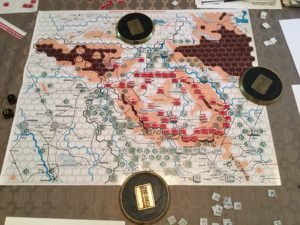


Weather. Why worry about it, right? Never a thought. It’s October…….crisp fall weather. Oh…….then just roll on the weather table for …..MUD. Ugh…..bad, bad amateur move. It stings even three weeks later.
OK, give it one more try. Another set up after dinner. Same bloody result. This time, more aggressive, greater gains. But, again, MUD.
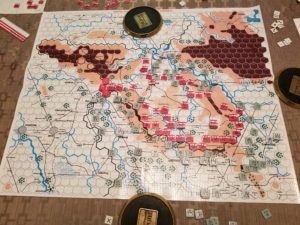
No wonder the General Staff was ready for a putsch. Tough army, difficult terrain, limited mechanized advantage, and an untried airforce lacking airfields. And, also, MUD.
I don’t know if Tim is ready for it, but I’d like to switch sides and see what he can do. He’s good, very good. But this is quite a challenge.
Good game in the tradition that is all best about the Europa system. And, given the strange and terrible saga of this system, it’s best to remember the good.
Tim arrived early Friday evening, just in time for the Stanford football game. I had the table set up and ready to go. We agreed to start playing early Saturday morning. Tim took the British (Allies) and I had the Italians (Axis) forces. The plan was an ambitious one. To play the entire scenario, and watch as many of the headline college football games as possible. Oh yes….and consume many Henry’s. This was a job for professionals.
The Italians face some serious operational challenges. They are considered Out of Supply (Status 4) from the beginning of the game. Attack strength is quartered, defense and movement halved, with reduced Zones of Control (ZOC). They have no General Supply sources, and must rely on a limited number of Attack Supply factors to create either General Supply Points, or use for attacks. Italian Colonial troops (which form the bulk of their forces) can have air support only if it involves ten regiments (REs). Air units must role on the Success Table to fly a mission, unless they are in General Supply. If not, they can be aborted, or fail to fly. To top it off, Italian movement is limited until the British enter Italian East Africa.
The British commander has his own problems involving time and space. Time is critical because the Order of Battle (OB) requires two divisions have to be withdrawn by early summer. The distances in the game are significant, and by Spring, the possibility exists that roads and terrain key areas will be reduced to muddy morasses, limiting movement and effecting combat.
Play started at 0830 with Game Day as background ambiance. Here’s a summary of play.
Dec I 1940 – Clear
Allies: South Africans advance from Kenya in the south, with air units destroying a SM-79 I had unwisely deployed at a forward air field. Advances from Khartoum in the north southwards towards Kassala-Bascia-Massaula.
Axis: Consolidate scattered units in the vicinity of Kassala using HQs.
Dec II – Clear
Allies: Continue Kenya advance. Defeat Italian force at Kassala.
Axis: Retreat from Kassala to Bascia.
Jan I 1941 – Clear
Allies: Continue advance from Kenya in the south. Defeat Axis regiments holding vicinity of Bascia in the north, using motorized machine gun battalions to envelope for ZOC kill. Indian 4th Division advances south along coast from Port Saud.
Axis: Counter-attacks and destroys motorized machine gun battalions. Retreats east to mountains near Massaula.
Jan II – Clear
Allies: Advance along coast from Kenya, takes Mogadishu with amphibious assault. In the North, 4th Division continues advance shrugging off (over running) delaying Italian regiments.
Axis: Withdraws southern and eastern forces north towards Addis Ababa. Forms hasty defensive positions around Massaula. Air strike against British airfields unsuccessful.
Feb I – Clear
Allies: Takes Keren (key to breaching mountain defenses outside Massaula) on a half-exchange. Advances towards Addis Ababa.
Axis: Continues to withdraw towards Massaula, but hampered by British ZOCs.
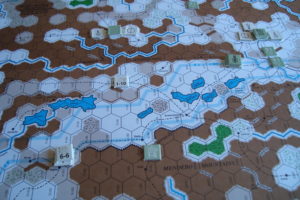
Feb II – Mud
Allies: Consolidate near Keren. South Africans now slog in mud towards Addis Ababa.
Axis: Establish defense around Massaula, continues to move/consolidate units near Addis Ababa.
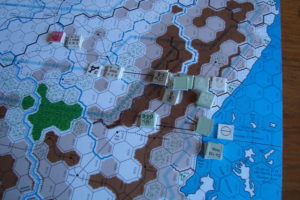
At this point , VIPs were tallied, with each side having two (2).
March I – Mud
Allies: Launch assaults on Massaula perimeter defenses. Slog in south continues.
Axis: Now defending Massaula proper.

March II – Mud
Allies: Capture Massaula (This will give them one (1) VIP), begin advance southwest towards Addis Abada. South Africans continue slog.
Axis: Forces in Addis Ababa deploy to forward defensive positions awaiting Allied advance.
April I – Mud (At this point Tim became understandably irritated by my uncanny ability to throw sixes. I pointed out to him that this was better for him with a weather role than a combat roll).
Allies and Axis: Same as March II.
At this point play stopped. We were engrossed in the Notre Dame-Texas game, and it appeared that the game would continue for more turns than time remaining to play.
Comments to follow.
Had a nice talk with Tim last night about our recent Wavell’s War game and, especially, his posted comments.
I had some real second thoughts about the validity of using scrapped unit replacement points to build new headquarters. Big sigh of relief when I checked the rules this morning and confirmed it is OK.
We also talked about the low level of victory point (VIP) totals in the game, especially since they are calculated, for the most part, in January and July, only. This makes the status of Massua absolutely critical. This city is worth three VIPs per initial phase on or after April I/II ’41 for the side that controls the city.
With this in mind, Tim’s analyses of his attack supply and railroad construction challenges are very pertinent to successful Allied play.
I think we agreed to try it again. The when is TBD.